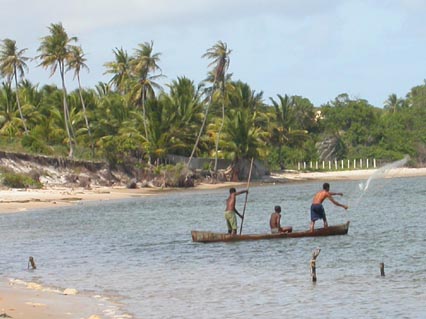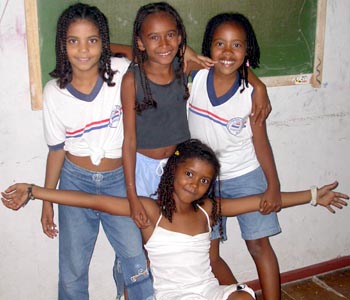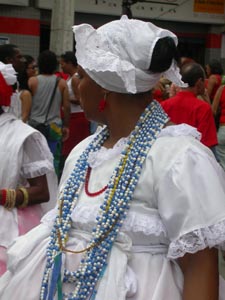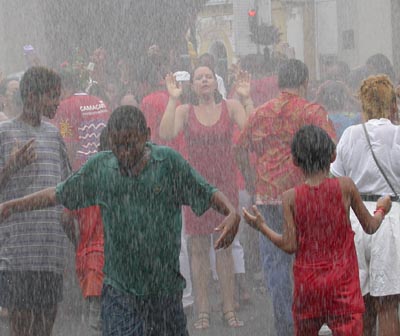Here in Seattle, it’s pouring buckets today. I turn up the heat, put on a pop CD called “Rouge,” and instantly, I’m transported to Brazil.
In my mind, I smell the tropical vegetation and the sea air. I feel the hot sun pouring down on my bare shoulders. I hear the upbeat sound of Rouge coming, not from my stereo, but from a battered truck driving down the street with huge speakers mounted on the outside.
These are the easy memories, the physical ones.
If it had been a simple beach vacation, most of the memories would have been like these. But it was not, and so, four years later, I’m still processing the rest.
That trip was the first of what would become Bahia Street’s small group study tours. There were seven of us, plus our guides, Margaret (of Seattle) and Rita (of Salvador).
We flew into Salvador, a city in northeast Brazil, and immediately we were whisked away to Arembepe (Air-em-BEP-ee), a small seaside town about a half hour down the road from the airport. We spent the evening on a veranda on the beach, drinking powerful caipirinhas and eating exquisite food — fried fish, tomato salad, and potatoes, presented on a stunning platter, lined with deep green leaves and accompanied by piles of ruby-red grated beets and neon orange grated carrots. We were getting to know each other as traveling companions, and that night, we told stories and laughed until we cried.

That was the only part of my Brazil trip that could be called a “simple beach vacation.”
The next day, driving through the countryside and along the beach, I snapped hundreds of photos. I was captivated by barefoot children, thatched huts, and women carrying their laundry to the river for washing.
As we traveled, Margaret and Rita began to gently educate us about the implications of what we saw. It was picturesque, but it was poverty: The people I photographed all suffered from a lack of healthcare, education, and income.


On our third day, I came down with an eye infection, and we stopped at a medical clinic. Even that was an education. We walked into a low concrete building, to a room with benches around the walls. Women sat there with their sick children, waiting for hours to see the doctor. We stood around, waiting, too. There was a lull, a momentary quiet that was broken by the sound of a child coughing. “Let’s go outside, ” Rita said. On the other side of the door, she shook her head. “That one’s going to die,” she said.
Over the course of the week, we learned a great deal about Brazilian systems, political, cultural, and socio-economic. Looking at the big picture, I could see how this poverty affects us all. Even someone in far-off, wealthy Seattle who doesn’t speak Portuguese.
It wasn’t all work and no play. We swam in the ocean and hung out at beach bars, thatched roofs on poles with cold beer. We took a canoe ride and spent a glorious day in dune buggies at Mangue Seco, a remote place with giant sand dunes and the largest palm trees I’ve ever seen. We hiked to a waterfall in the mountains and ate new and wonderful things like cashew fruit.
But we also passed roadside encampments, groups of families living in shacks of black plastic sheeting and scrap wood. They were part of Brazil’s Sem Terra movement, some of the country’s 1.5 million dispossessed, landless people.
Seeing the desperation of the landless people helped prepare me for the shantytowns. Both groups seem like refugees in their own country, eking out a living as best they can.
After about a week traveling the countryside, we arrived back in Salvador. Our briefings on the road had prepared me for the danger, the crowds, the shantytowns. And when we finally visited the Bahia Street Center, it all came together, and I could see where I fit into the picture.
The quote from Margaret Mead was brought home to me that day: “Never doubt that a small, group of thoughtful, committed citizens can change the world. Indeed, it is the only thing that ever has.”


The last day of our tour was the Santa Barbara festival, an early December event celebrating the patron saint of firefighters. I was overwhelmed by the crowds, a human sea dressed in red, and the elaborate flower-covered palanquins bearing statues of Santa Barbara.


We followed the procession to the fire station, where the emcee and a bishop were perched in a cherry-picker above the crowd. The emcee kept shouting over the loudspeaker, “Viva Santa Barbara!” and everyone would respond with a loud cheer. Suddenly, Rita grabbed us and dragged us back against the wall. They turned on the sprinklers from the cherry picker, and the crowd was drenched with holy water. Rita’s quick action kept our cameras dry.
Standing against the wall, I watched a woman go into a religious trance, her arms upraised and her eyes closed. Her red dress clung to her body, and the crowd milled and spun around her, thrilled with the drenching.

Then the holy water shower ceased, and we headed out of the fire station. Although we had seen only blue skies and no rain since we arrived, it suddenly began to rain. “It always does that today,” said Rita.
In the African-Brazilian religion of Candomblé, Santa Barbara has a powerful equivalent, an Orixá, or goddess, called Iansã. I think she was responsible for the rain.
It was powerful experiences like these that I am still processing today.
I have not been back to Brazil yet. There are many other places in the world that I want to see first. But the lessons I learned in Brazil are lessons I take with me on all my travels, whether it’s a fishing village in Newfoundland or a native village in Alaska.
Things are not always as they seem. Look deeper. Listen. Get involved, stay a while, and gradually, things will reveal themselves.
A trip like this could change your life. It might lead you to improve the lives of others. And if you’re thoughtful and committed, it might change the world.
For more information about taking a Bahia Street study tour, e-mail me or visit the Bahia Street website. The next tour is scheduled for June of 2007.
